Baby donkey troubles: A Mamaku donkey rescuer explains the sad reality for many donkeys in New Zealand
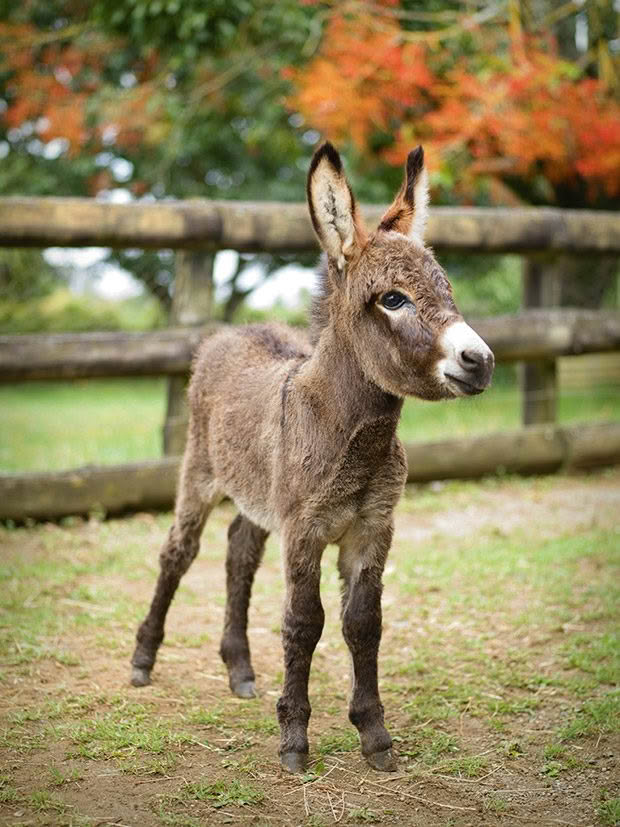
A baby donkey is one of the cutest farm animals, and it’s easy to fall in love. Unfortunately, donkeys are often neglected or mistreated. We meet a woman who has dedicated her life to rescuing wonky donkeys.
Words & images: Virginia Long Additional images: Rachael McKenna
Who: Pauline Sainsbury (pictured with Rosie)
What: Mamaku Rehoming and Rescue Centre
Land: 4ha (10 acres)
Where: Mamaku, 20 minutes north-west of Rotorua
The first time Pauline Sainsbury met Milo he was completely wild. He wouldn’t wear a halter because his head had grown into the first one someone put on him as a baby.
It took six men to wrestle him onto a float so she could transport him to her block. “He’s retired now at 24, but he was really nasty when he first arrived here.”
Fortunately for Milo, he was a naturally un-wonky donkey. “I couldn’t pick up his feet because he kicked. Luckily, he had good feet. That’s what saved him.”
Almost 300 rescue donkeys have followed in Milo’s hoofprints in the 10+ years since Pauline first met him, but the welfare issues they face are the same: wonky, overgrown, painful hooves, raging hormones in jacks making them unmanageable, lack of training, and a general lack of knowledge of the unique needs of donkeys.
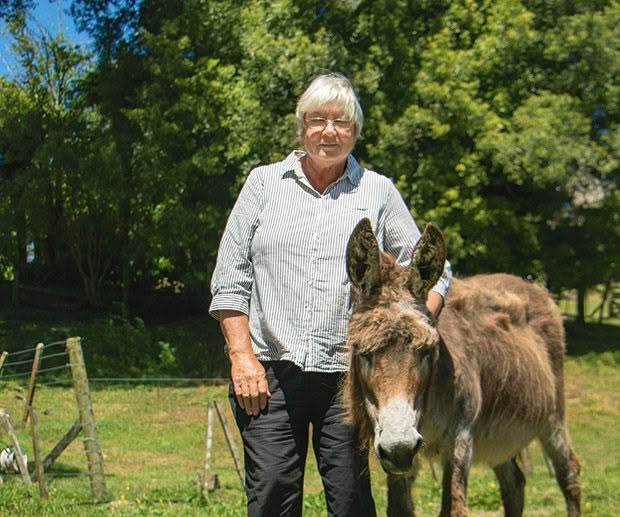
Pauline and Rosie.
People are enraptured by the high ‘cute factor’ of a donkey, especially fluffy foals. Pauline says most people have fond memories of Winne the Pooh’s friend Eeyore, or they loved donkey rides on the beach as children.
The biggest problem is beginner donkey owners who fall in love and buy small, cute entire male (jack) foals. They quickly find they are nothing like Eeyore, says Pauline. Jacks are incredibly challenging to handle and impossible to sell.
“If people gelded them there wouldn’t be a problem,” says Pauline. “But they say it’s too expensive. But you shouldn’t buy a donkey and think they are going to be cheap to look after.”
Some donkeys end up at her rescue because people’s circumstances change.
“Many are lovely donkeys,” says Pauline. “It’s often where people have downsized (off a lifestyle block and moved back into town) or are moving on to a rest home or village, bad health, or have just lost interest in the donkey. It just gets too hard. Sometimes the donkeys have health issues – bad feet or teeth – and they’ve just had enough.”

Donkey rescuers around NZ find it’s common for people to sell their lifestyle block and leave an unruly donkey behind for the new owners. In many cases, the donkey has been relegated to a far-off paddock, out of sight, out of mind, with no thought to its future or welfare.
Pauline is now compiling a second photograph album of her rescues. She says it’s important people know donkeys require a great deal of care and maintenance to keep healthy.
“Many people buying donkeys have no idea how to look after them. They don’t understand that a donkey’s feet must be trimmed (at least) three to four times a year, have its teeth seen to by an equine dentist, how to teach their donkey to lead on a halter and pick up its feet.”
Donkeys don’t naturally know how to pick up their feet, as a farrier requires, so the undersides can be trimmed back. If an owner is scared by a donkey stamping a hoof or kicking out with their back legs when they attempt to lift an animal’s legs, they stop trying.
Hooves grow quickly. They can get so long they resemble long, curling Persian slippers (see below). This is painful for a donkey, and it’s often impossible for them to walk. Some donkeys are euthanised because of incurable lameness due to untrimmed hooves.
THE RESCUE DONKEYS OF MAMAKU
Pauline’s hilly block can be home for 15 (sometimes more) donkeys at a time. A rescue donkey might need several months to a year of rehabilitation, training, and love before they’re ready for a new home.
The paddock closest to her home is for the newly-arrived donkeys where they are pampered and often put on a special diet of sugarbeet, salt, psyllium husks, minerals, and hay.
Some donkeys never leave. The following are all common examples of what Pauline finds when she rescues a donkey. She hopes by sharing their stories, people will think twice before taking on a donkey if they are unprepared and/or inexperienced.
Milo
Milo was Pauline’s first rescue, left behind on a lifestyle block which had been sold. The new owners didn’t want him.
“I was rung by our donkey rescue person, Susan, in Napier and asked if I wanted a challenge,” says Pauline. Milo had been bought as a cute fluffy foal and was completely unhandled, except for when Susan travelled to trim his feet a couple of times a year.

Milo (left) and Christmas.
“He was not for the faint-hearted, and even Susan was nervous doing his feet.”
At five years old, he was completely wild. The property’s new owners were persuaded to have Milo gelded before Pauline went to collect him, the operation paid for by the Donkey & Mule Protection Trust.
When Pauline arrived to pick him up, the owner was busy following him around the pen with a brush.
“I asked him why he didn’t just put a halter on him? He told me that Milo was fed up with halters as he’d had a halter left on him since he was a foal which hadn’t been removed as he grew. His face was forced to grow into the halter.”
You wouldn’t know Milo had a sad start when you visit Pauline’s block today.
“He was a success story. I eventually broke him to harness and took him to shows.”
Milo is now a much-loved, permanent resident at Mamaku, over-seeing the hundreds of rescue donkeys that have come to Pauline’s block since 2008.
Minty
Minty was brought over on a barge from Ponui Island near Auckland as a cute foal and sold at auction. He was left entire. As he grew, his new owners quickly found they couldn’t handle him.
He was passed on to a farmer who kept him with bulls. There is a misconception by bull farmers that donkeys stop bulls fighting – it’s “completely not true,” says Pauline.
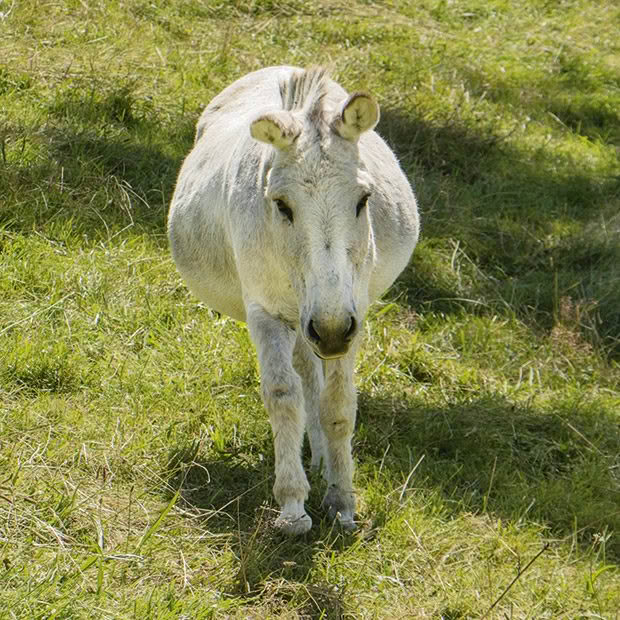
The farmer soon got sick of him, and Minty was given to a lady who already had a jenny and a jack. Putting two male donkeys together is a recipe for disaster, says Pauline, and Minty nearly killed the other jack.
Back on Trade Me, Minty was eventually taken to Mamaku, where he was gelded. Donkeys are not the same physiologically as horses and can be tricky to geld. Excessive bleeding is a common problem. Minty developed an infection and needed antibiotic injections daily.
“Have you ever tried to inject a wild donkey?” asks Pauline. “Whenever I tried to inject into his rump he would spin round and kick me. Eventually, we bonded, and I could catch him and do his feet. I tried to re-home him, but it didn’t work out because he’d bonded with me so much. He’s still here and will be forever.”
Hudson & Tito
The two jack foals were bred by a donkey farmer in Otorohanga and sold un-gelded.
“They were bought by a lady who already had horses, but these two were a handful. They were quite dangerous. She thought once they were gelded, they would be ok, but in the end, she admitted that she was quite frightened of them and wanted them gone.”
Pauline picked up the naughty pair, worked with them until they were easy to catch, have their feet handled, and were lovely
and quiet.
They were re-homed to an experienced horseman.
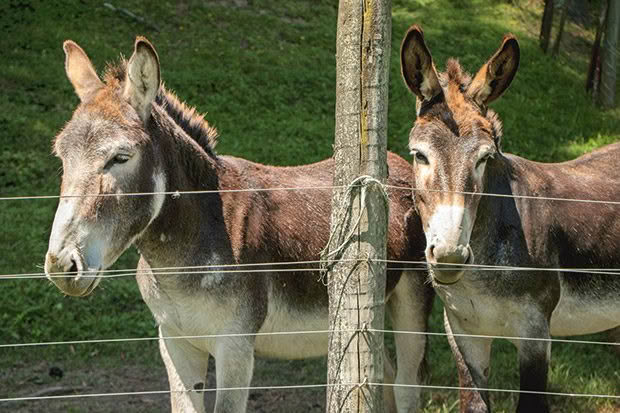
“Sadly, that didn’t work out because the new owner lost interest in them and (didn’t) touch their feet the whole time,” says Pauline.
“He rang me to say he couldn’t keep them anymore and neighbours had dobbed him into the SPCA because their feet were really bad. In the end, I worked with the SPCA, and their farrier did their feet. They were all bulging and twisted. A complete mess. I still have to get the farrier to do their feet in the crush. I might attempt to do their front feet, but Tito is inclined to swing around and kick you.
“It just goes to show that even though some people think they are experienced, they aren’t. (The horseman) just couldn’t gel with them.”
Neddy
Neddy came from Waihi, again sold as a cute but entire little foal. The family that bought Neddy already had horses but soon couldn’t handle him.
Neddy was passed onto another home, where he was badly treated. He was about to be sent off for pet food when he got
a reprieve and ended up at Mamaku.
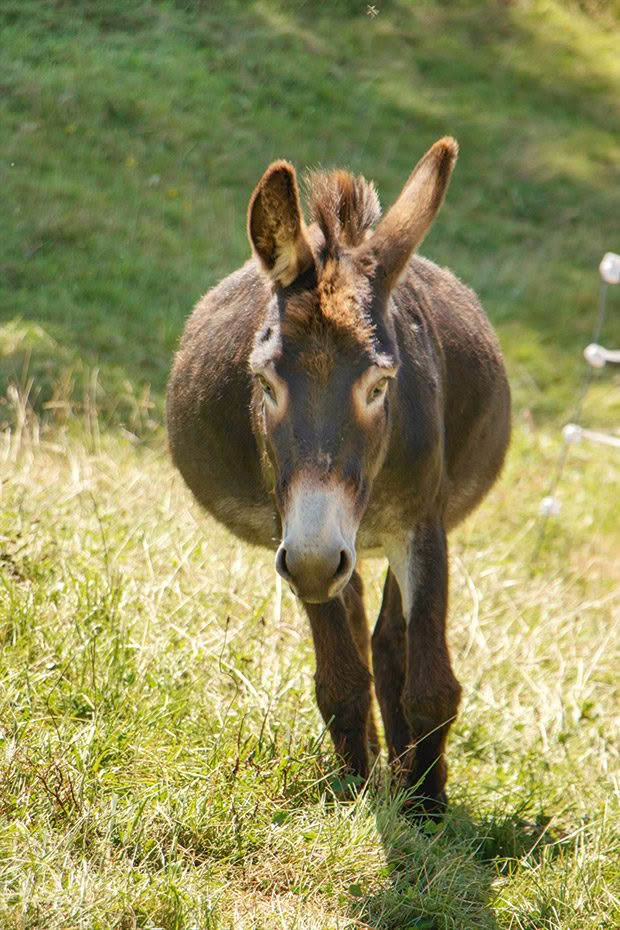
“He was flighty, like a horse, and was ready to attack me when I went to load him into the float. I thought, ‘great, here’s another challenge!’” says Pauline.
Once gelded, Neddy quietened down. “I’ve bonded with him too, and Neddy is lovely now. I did try to rehome him with another donkey, but the lady just couldn’t bond with him. It takes a long time, so he’s permanently here now.”
WHAT TO CONSIDER BEFORE YOU GET A DONKEY
The number of unwanted and abandoned donkeys is so high, NZ has six re-homing centres, three in the North Island and three in the South Island. Pauline works closely with the Donkey & Mule Protection Trust of NZ.
Taking on a donkey, even if you are experienced with horses, requires a would-be owner to ask themselves:
• do I have the knowledge and skills necessary to keep it healthy and happy?
• am I willing to pay the cost of gelding (if it’s male)?
• donkeys need to be with another donkey – do I want the long-term commitment and cost of maintenance for two animals?
• am I happy to commit to 30-40+ years of ownership?
It’s straightforward to buy a donkey. They are often sold on Trade Me, and there are people breeding them by the dozen. They will happily sell you the most adorable-looking, cuddly, fuzzy little male foal at what may seem like a reasonable price (approximately $600).
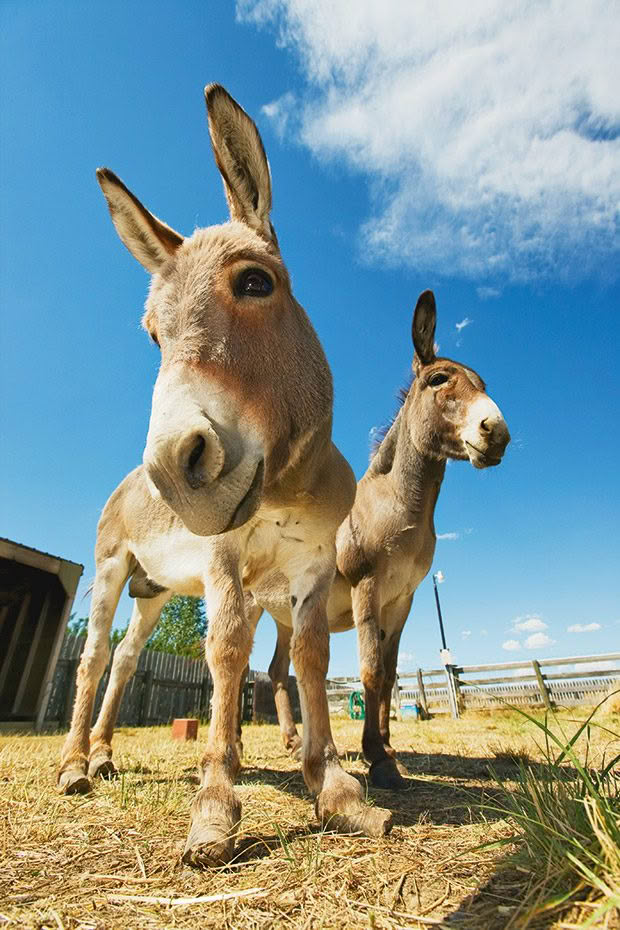
A jenny (female) costs more, $800-$1000, or more in the South Island. These prices are for your average farm donkey. Miniature donkeys are much rarer, specially bred to conform to breed standards, and sell for a lot more.
Gelding a jack while it’s still a foal is crucial, as the older it gets, the riskier the operation. It costs approximately $450-$600 dollars, depending on where you live, your access to equine vets, and the donkey’s weight.
Gelding is a necessity if you want to keep your donkey as a pet, says Pauline, taking the ‘true’ cost of a jack much higher than it first appears.
An ungelded donkey is equivalent to owning a stallion. A well-trained jack, correctly handled, can be very well-behaved and quite affectionate.
However, it’s not an animal for an inexperienced person with no equine skills. You need to have a great deal of knowledge and experience handling them if you are to stay safe.
An adult jack can weigh up to 400kg. A well-aimed boot from his hind legs can cause serious injuries. He may also bite, lash out with his front feet, or place you (or others) in dangerous situations if he has not been schooled correctly.
Pauline tries hard to rehome the donkeys she rescues. She has help from fellow donkey rescuers Alan and Wendy Baguley, from Whakatane, and friend Debbie Flemming.
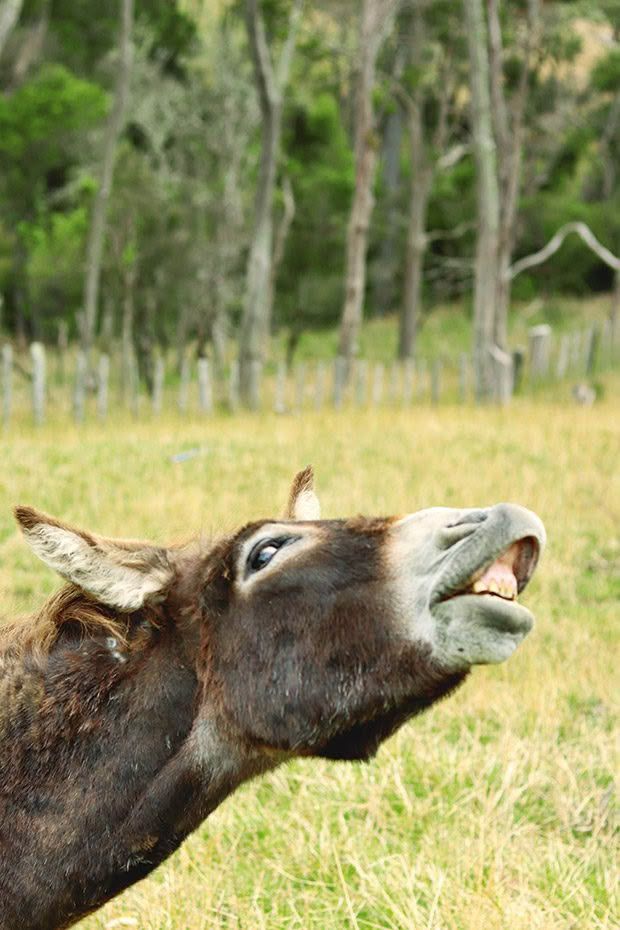
“I don’t think people realise just how long they live for, and with many people going onto lifestyle blocks in their 60s, they haven’t thought it through.”
Pauline has a waiting list of people wanting donkeys.
“I just don’t have any donkeys suitable for inexperienced people, and donkeys like Hudson and Tito would have to go
to experienced people.”
Pauline’s rescues are not free to good homes. She has a standard charge of $200. “This just goes towards costs. I pick up and deliver and rely on owners to give a donation.”
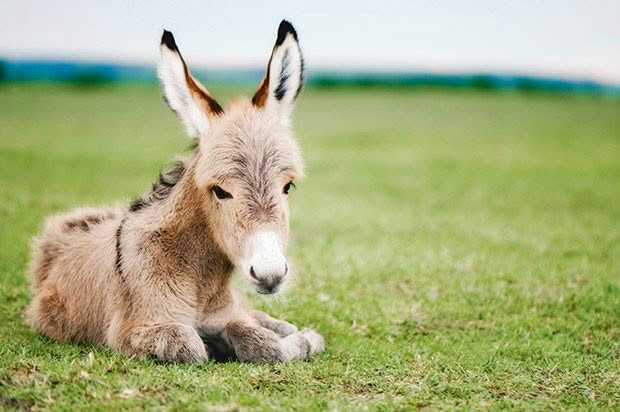
Anyone wanting one of her donkeys is carefully vetted. “I like to visit the property and ask a lot of questions. Is there shelter for the donkey (donkey’s coats are not waterproof, and they are prone to pneumonia), are there dogs, children, what are their fences like, pasture, avocado trees (which are poisonous). I ask some very serious questions.
“If I think it’s going to work, I try to match the donkeys to the people, and 99 percent of the time it works.”
DONKEY & MULE PROTECTION TRUST
Resources include helpful advice, and free booklets you can download, including:
• Before you buy a donkey
• What to feed your donkey
• Looking after your donkey’s feet
If you have an unwanted donkey, please contact the trust via its website.
MORE HERE:
Love this story? Subscribe now!
 This article first appeared in NZ Lifestyle Block Magazine.
This article first appeared in NZ Lifestyle Block Magazine.
